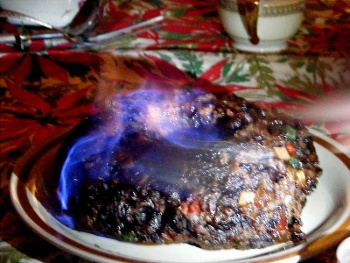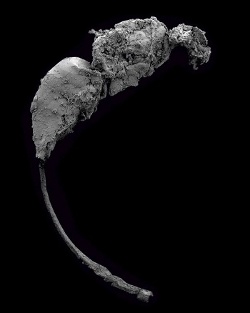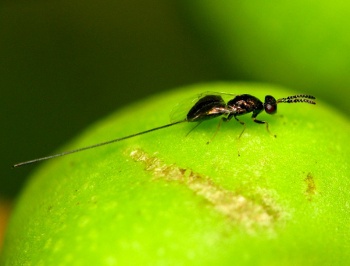Fossil Fig Wasp
December 20, 2013
The ancient question of what came first, the
chicken or the
egg, has been answered by modern
genetics. The first chicken, however you might define that
species, came from an egg layed by a
mother who was not a chicken, so the egg came first. Interestingly, if we were to ask whether the
fig wasp or the
fig came first, a recent
fossil discovery indicates that it was the wasp, not the fig.[1-2] This is a good topic for this
holiday time of year known for
figgy pudding.
Figgy pudding, of course, is a pudding made from figs, and the first reference to it was in
England in the
16th century. Ref. 3 gives a
recipe for figgy pudding from the
Food Network.[3] Although the recipe does contain figs, it's loaded with other
delectable ingredients, such as three times as many
dates, and some
dark chocolate.
Most of us would not know of figgy pudding were it not for the
Christmas carol,
We Wish You a Merry Christmas, which has the
chorus,
Now bring us some figgy pudding
Now bring us some figgy pudding
Now bring us some figgy pudding
and bring it us here.

The holidays are definitely a time for excess.
This is figgy pudding with flaming brandy.
(Photo by Ted Kerwin, via Wikimedia Commons.)
The fossil fig wasp was discovered in
Brazilian Lower Cretaceous Crato Formation Lagerstätte by
Nathan Barling and
David M. Martill of the
University of Portsmouth (Portsmouth, UK) and
Sam W. Heads of the
University of Illinois at Urbana–Champaign (Champaign, IL) and the
Illinois Natural History Survey.
The lower Cretaceous was the period between 100-146
million years ago when the first
flowering plants (angiosperms) appeared. This fossil, dated to be about 115 million years old, is the first
Mesozoic parasitic wasp (
Peteromalidae), and it's described in a recent issue of the
journal,
Cretaceous Research.[1]
The time period of the fossil is quite a while after the earliest evidence of an
insect in the
fossil record. That's the
Rhyniognatha hirsti, found in the
Rhynie chert, a
sedimentary deposit dated to the
Devonian period, which extended from about 420-360 million years ago.[4]
As I wrote in a
previous article (Flowers, November 1, 2013), a large radiation of insects, the
beetles, occurred about 300 million years ago, and
flying insects appeared about 250 million years ago. Although the fossil fig wasp is dated to be about 115 million years old, this is about 65 million years before the earliest figs.[1-2]

The fig wasp fossil is only 3.5 mm long if the ovipositor is excluded.[1]
The period of the fossil is roughly 65 million years before the occurrence of figs, but its ovipositor closely resembles that of a modern fig wasp.[2]
(University of Illinois photo by Sam Heads.)
The wasp is a member of the
Hymenoptera superfamily,
Chalcidoidea, which includes about 22,000 discovered
species, and it may have as many as 500,000 species still to be cataloged.[2] These wasps parasitize other insects,
spiders and some
plants.
One explanation of the wasp's appearance before figs is that the wasp could have been adapted to an earlier
fruit, and it later became associated with the fig.[2] Heads doesn't rule out the actual existence of figs at that time, but there is no evidence for this. Says Heads, "There is no evidence of the existence of figs at this time and the most recent molecular study doesn't place figs that far back."[2]
The fossil wasp's
ovipositor, the rear organ through which it lays its eggs, is very similar to that of modern fig wasps, as seen in the photograph, below. Its ovipositor is used to lay eggs inside figs.[2]

A modern fig wasp, Hymenoptera: Chalcidoidea: Sycophaginae.
(Photo by Sergio Jansen Gonzalez, via the University of Illinois.)
Heads has one general observation of his field of
paleontology,
"When you talk about paleontology to people the first thing they think of is dinosaurs... And that's great. Dinosaurs are really exciting, wonderful animals. But for the most part, they're extinct. With insects and other arthropods like spiders and scorpions, they're around still. So we have modern forms to compare our fossil forms to, which is incredibly useful."[2]
References:
- Nathan Barling, Sam W. Heads and David M. Martill, "A new parasitoid wasp (Hymenoptera: Chalcidoidea) from the Lower Cretaceous Crato Formation of Brazil: The first Mesozoic Pteromalidae," Cretaceous Research, vol. 45, October 2013, pp. 258–264.
- Diana Yates, "Ancient 'fig wasp' lived tens of millions of years before figs," University of Illinois Press Release, December 5, 2013.
- Warm Sticky Figgy Pudding Recipe by Jade Thompson, The Food Network.
- Michael S. Engel and David A. Grimaldi, "New light shed on the oldest insect," Nature, vol. 427, no. 6975 (February 12, 2004), pp. 627-630.
Permanent Link to this article
Linked Keywords: Chicken; egg; genetics; species; mother; fig wasp; fig; fossil; holiday; figgy pudding; England; 16th century; recipe; Food Network; delectable; ingredient; date; dark chocolate; Christmas carol; We Wish You a Merry Christmas; refrain; chorus; flambé; flaming brandy; Ted Kerwin; Wikimedia Commons; Brazil; Brazilian; Early Cretaceous; Lower Cretaceous; Crato Formation; Lagerstätte; Nathan Barling; David M. Martill; University of Portsmouth (Portsmouth, UK); Sam W. Heads; University of Illinois at Urbana–Champaign (Champaign, IL); Illinois Natural History Survey; million years; flowering plants; Mesozoic; parasitic wasp; Peteromalidae; scientific journal; Cretaceous Research; insect; fossil record; Rhyniognatha hirsti; Rhynie chert; sedimentary deposit; Devonian; period; beetle; Pterygota; flying insects; millimeter; mm; ovipositor; Hymenoptera; superfamily; Chalcid wasp; Chalcidoidea; spider; plant; fruit; ovipositor; paleontology; dinosaur; animal; extinction; extinct; arthropod; scorpion.